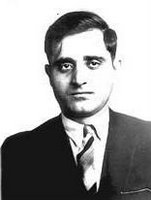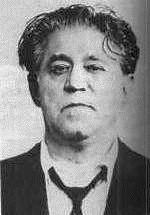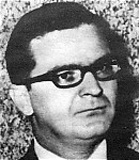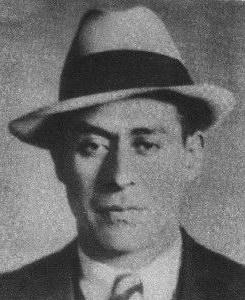
Joseph John Aiuppa, also known as "Joey O'Brien" and "Joey Doves", was a Chicago mobster who became a leader of the Chicago Outfit from 1971 until his skimming conviction in 1986.

Anthony John Spilotro, nicknamed "Tony the Ant", was an American mobster and high ranking member for the Chicago Outfit in Las Vegas during the 1970s and '80s.

Anthony Joseph Accardo, also known as "Joe Batters" and "Big Tuna", was an American longtime mobster. In a criminal career that spanned eight decades, he rose from small-time hoodlum to the position of day-to-day boss of the Chicago Outfit in 1947, to ultimately becoming the Outfit authority in 1972. Accardo moved the Outfit into new operations and territories, significantly increasing its power and wealth during his tenure as boss.

Paul De Lucia, known as Paul Ricca, was an Italian-American mobster who served as the nominal or de facto leader of the Chicago Outfit for 40 years. In 1958 he was named "the country's most important criminal" by a Senate crime investigating subcommittee. Ricca died on October 11, 1972.

The Chicago Outfit is an Italian-American organized crime syndicate or crime family based in Chicago, Illinois, which originated in the city's South Side in 1910. It is part of the larger Italian-American Mafia.
Chicago, Illinois, has a long history of organized crime and was famously home to the American mafia figure Al Capone. This article contains a list of major events related to organized crime.

Francis John Schweihs, aka "Frank the German", was an American gangster, who worked for The Outfit, the organized crime family of Chicago. At the time of his death, federal prosecutors planned to indict him for numerous crimes, including murder. It is believed he had participated in, or had knowledge of, many murders going back decades, including brothers Anthony "Tony the Ant" Spilotro and Michael Spilotro, Allen Dorfman of the Teamsters Union, a disgraced Chicago cop, Outfit associate and informant Dick Cain, Outfit boss Salvatore "Sam," "Mooney" Giancana, loanshark Sam "Mad Sam" DeStefano, Outfit hitman Charles "Chuckie" Nicoletti and others.
Charles Nicoletti, also known as "Chuckie the Typewriter", was an American mobster of the Chicago Outfit, who served as hitman under boss Sam Giancana before and after Giancana's rise and fall. Nicoletti was murdered on March 29, 1977.

Felix Anthony "Milwaukee Phil" Alderisio was an American enforcer, bagman, hitman and burglar for the Chicago Outfit. He was underboss to Sam Giancana during the 1960s and boss from 1967 to his imprisonment in 1969.
Salvatore Joseph "Sam" Battaglia was an American mobster and high-level member of the Chicago Outfit criminal organization.
Fiore "Fifi" Buccieri was a Chicago mobster and member of the Chicago Outfit who specialized in loansharking.

Louis "Little New York" Campagna was an American gangster and mobster and a high-ranking member of the Chicago Outfit for over three decades.
William Daddano Sr., also known as "William Russo" and "Willie Potatoes," was a top enforcer and loan shark for the Chicago Outfit and a participant in some high-profile robberies.

Samuel "Mad Sam" DeStefano was an American mobster who was associated with the Chicago Outfit. He was one of the organization's most notorious loan sharks and sociopathic killers. Chicago-based Federal Bureau of Investigation (FBI) agents, such as William F. Roemer Jr., considered DeStefano to be the worst torture-murderer in the history of the United States. The Outfit used the mentally unstable and sadistic DeStefano for the torture-murders of Leo Foreman and Arthur Adler, the murder of DeStefano's younger brother, Michael DeStefano, and many others. However, due to DeStefano's deranged mental state, the Outfit never let him become a made man. At least one Outfit insider, Charles Crimaldi, claimed DeStefano was a devil worshipper.
James Vincent "Turk" Torello was an Italian-American mobster who became a caporegime and leading enforcer for the Chicago Outfit during the mid-to-late 1970s.

Homer Virgil Van Meter was an American criminal and bank robber active in the early 20th century, most notably as a criminal associate of John Dillinger and Baby Face Nelson.

Richard Cain, also known as Richard Scalzitti, was a notoriously corrupt Chicago police officer and a close associate of Mafia boss Sam Giancana.

Franklin Rio also known as "Frank Rio" and "Frank Cline" was a member of Al Capone's Chicago-based criminal organization known as the Chicago Outfit. He was also an alleged gunman in the famous 1929 St. Valentine's Day Massacre.

Salvatore Mooney Giancana was an American mobster who was boss of the Chicago Outfit from 1957 to 1966.
This is a list of organized crime in the 1900s, arranged chronologically.












